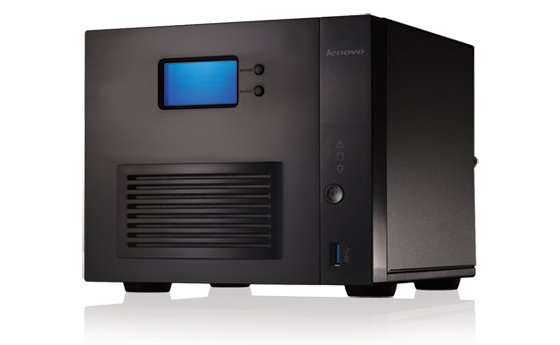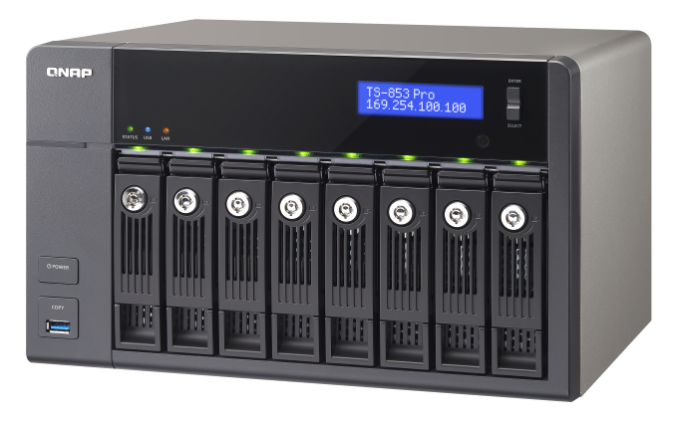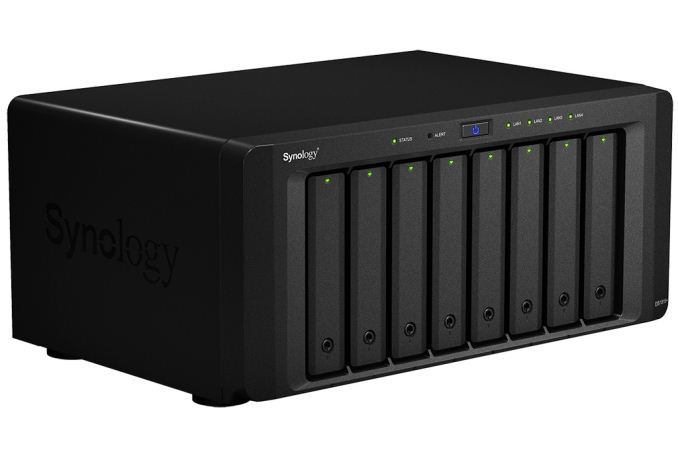Holiday Guides 2014: COTS NAS Units
by Ganesh T S on December 17, 2014 7:00 AM EST- Posted in
- NAS
- Storage
- Enterprise
- Holiday 2014

We have already published holiday guides for mobile devices, motherboards, GPUs and SSDs. Today, we will take a look at the various options available in the commercial off-the-shelf (COTS) network-attached storage (NAS) market space.
Unlike, say, the GPU market, the COTS NAS market can't be simply delineated based on price and performance. At the basic level, the only aspect that is guaranteed is the fact that the price of a NAS increases with the number of bays in it. Any consumer in the market for a NAS needs to consider the following aspects before choosing a budget:
- Amount of storage needed (number of bays)
- Intended use-case
- Business-oriented or home / multimedia-focused
- Expected number of simultaneous clients
- Downtime tolerance
- Required processing power (both file-serving and tangentially related tasks)
- Value of invested time (in the case where there is a toss-up between the COTS and DIY routes)
- Mobile and native NAS applications ecosystem
We have evaluated a large number of NAS units (with different bay-counts) over the last couple of years. The lineups mentioned below (in alphabetical order) are the ones that we are comfortable recommending for purchase after putting a few of their members through long-term testing.
- Asustor Storage Units
- Lenovo i- and p- Series
- Netgear ReadyNAS 300, 500 and 700 Series
- QNAP Turbo NAS Units
- Seagate NAS and NAS Pro Units
- Synology DiskStation and RackStation Series
- Western Digital My Cloud EX Series
Even though two-bay NAS units are a good fit for the average consumer, the typical AnandTech reader is probably looking at units with four or more bays. With this in mind (and the reviews that we have published before), the rest of this guide will focus only on four and eight-bay diskless units. Another point to note is that we are not considering the multitude of offerings that come with Windows Storage Server or some similar flavor. Only products based on custom OSes are being considered in the guide.
Option 1: Lenovo ix4-300d [ $210, Review ]
Despite being released almost two years back, Lenovo continues to keep the firmware updates flowing (with the latest one addressing vulnerabilities and improving the UI released earlier this month). One of the updates also fixed our main gripe in our original review - the unit's shares disappearing and hardware locking up after a few weeks in operation, with a power cycle being the only way out. I have been running the unit without reboots since June 2014 and am happy to say that the unit is now fit to enter our recommendation list.
The list of reasons to choose this are below. If any of these don't apply, feel free to move on to the other options.
- The budget is tight
- Downtime can be tolerated (i.e, no hot-swap capabilities)
- Limited memory (512 MB) is not an issue (i.e, no plans to run hungry apps)
- Limited native app selection and a barebones mobile app are not issues
On the plus side, the ix4-300d has two gigabit links and also supports 802.3ad dynamic link aggregation. The ~$200 street price makes it an absolute steal.
Option 2: QNAP TS-451 [ $466, Review ]
Option 3: QNAP TS-853 Pro [ $1236 - 8GB Version ; $986 - 2GB Version ]
The QNAP TS-451 and TS-853 Pro are perfect choices for power users in a home scenario with multimedia-heavy workloads (in terms of streaming videos to various devices with different transcoding requirements). The current Newegg listing for the TS-451 includes 4 GB of DRAM compatible with the TS-451. Augmenting the internal memory of the unit can make it fit to run a virtual machine using QNAP's Virtualization Station package. The TS-451 is perfect for users expecting 1 - 5 simultaneous video streaming clients connected to it. For those wanting to experiment with multiple simultaneous virtual machines / requiring more number of bays, the TS-853 Pro is an excellent, albeit, much costlier choice. Our review of the TS-853 Pro should go up before Christmas. Obviously, since we are recommending the unit here, we didn't find any showstopper issues while evaluating it. The 2 GB version can't run virtual machines. The 8 GB version is the one to choose if you are planning on running some VDI applications.
The mobile and native NAS applications ecosystem of QNAP is one of the best in the market. Both Synology and QNAP are on par with respect to this aspect, and the competition between them has turned out to be very good for the consumers. The main reasons to choose a unit in the the TS-x51 or the TS-x53 Pro series are listed below
- The expected use-case is multimedia-heavy, with extensive streaming and transcoding requirements
- The mobile applications need to be top-notch
- There is a need to retire a physical machine (by converting it into a virtual machine running inside the NAS)
Option 4: Synology DS415+ [ $600, Review ]
Option 5: Synology DS1815+ [ $1050, Review ]
Both Synology and QNAP have excellent mobile apps and third-party apps for their operating systems. Though QNAP has some nifty differentiating features such as the ability to run virtual machines using Virtualization Station, Synology wins out on core features for the business users. In particular, if iSCSI support is important, the options provided by Synology are simply unparalleled in the sub-$2000 COTS NAS market space.
The performance benefits (particularly in terms of latency) provided by Rangeley over Bay Trail, coupled with true hardware acceleration for encrypted shared folders make the DS415+ and DS1815+ easy to recommend for business users. Simply put, if you run a SOHO / SMB and need a fast and reliable NAS which excels at its core task of handling storage functions, the Rangeley-based Synology units are the best fit.
Honorable Mentions:
Home users looking for a single point of contact for both the NAS and the hard drives can opt for the WD Red-equipped My Cloud EX4. Recent firmware updates have improved RAID-5 performance. Similarly, SOHO / SMB users with similar 'single point of contact' requirements can opt for the Seagate NAS and NAS Pro units.
If disaster-resistance is needed, there is no alternative to the ioSafe units. The ioSafe 1513+ is fit for business users, while the ioSafe 214 is good for home users. Since both units run Synology DSM, the overall experience is great.
Except for the Netgear ReadyNAS units, all others use EXT3 / EXT4 filesystem for the RAID volumes. Netgear is hoping to stand out in the crowd with the use of btrfs. We did evaluate the RN312 (2-bay Atom-based unit) and the RN716X (6-bay Xeon-based with 10GBASE-T capabilities) last year, but haven't had the chance to put them through long term testing yet. Other than the fact that I would like the new approach to gather some more field reports, I am very impressed with what Netgear is able to provide with the new systems: snapshotting with virtually zero overhead for protection against accidental deletion and data scrubbing / bit-rot protection with minimal overhead. I would personally be wary of trusting a btrfs-enabled ReadyNAS unit with the only copy of any data, but the benefits of ReadyNAS OS 6.x do make a compelling case for testing out.
A look at a couple of build options for DIY NAS units will be published next week.













26 Comments
View All Comments
sandwich_hlp - Thursday, December 18, 2014 - link
I was wondering the exact same thing.ganeshts - Thursday, December 18, 2014 - link
Two links to peruse:http://www.restoringdata.ca/drobo-recovery-service...
http://www.anandtech.com/show/8399/recovering-data...
In addition, we can only recommend units that we have had personal experience with. We tried contacting Drobo for a review unit many years ago, but they have never responded.
praeses - Thursday, December 18, 2014 - link
Would Lime Technology's (UnRAID) AVS-10/4 classify as COTS or would that be more whitebox/OEM (or fall into the DIY stuff as mentionned at the end)?Gigaplex - Friday, December 19, 2014 - link
The RN716X is a 6-bay device running btrfs? Uh... btrfs is still experimental/unfinished with regards to RAID5/6. Are they nuts?ganeshts - Friday, December 19, 2014 - link
It is an interesting situation - Since they are COTS, they don't need to offer ALL advantages of btrfs to the end-user - just what they claim in their marketing collateral / consumer pitch.. So, the way Netgear is able to offer it to the consumer base traditionally used to RAIDx w/ ext3/4 is by making the BTRFS volumes sit on top of a traditional md file system to support RAID5/6. This balances the familiarity of mdadm-based RAID with some essential features of btrfs (not all advantages of btrfs are available in the current implementation).mpbrede - Monday, December 29, 2014 - link
I must be slowly going insane. I could swear that when I read this article after it was originally posted there was reference to a forthcoming (next week) review of DIY NAS setups. I remember thinking that would be great to make a decision before I pull the trigger on a replacement system for my home NAS.Then the next week, I looked for the article, it wasn't there, the same promise was still in the opening paragraphs for this article and I thought "well, it's Christmas, it'll probably be out the week after."
Now it's the week after, and there is no mention of a DIY NAS review or article anymore.
Are those the men in white coats I see...?